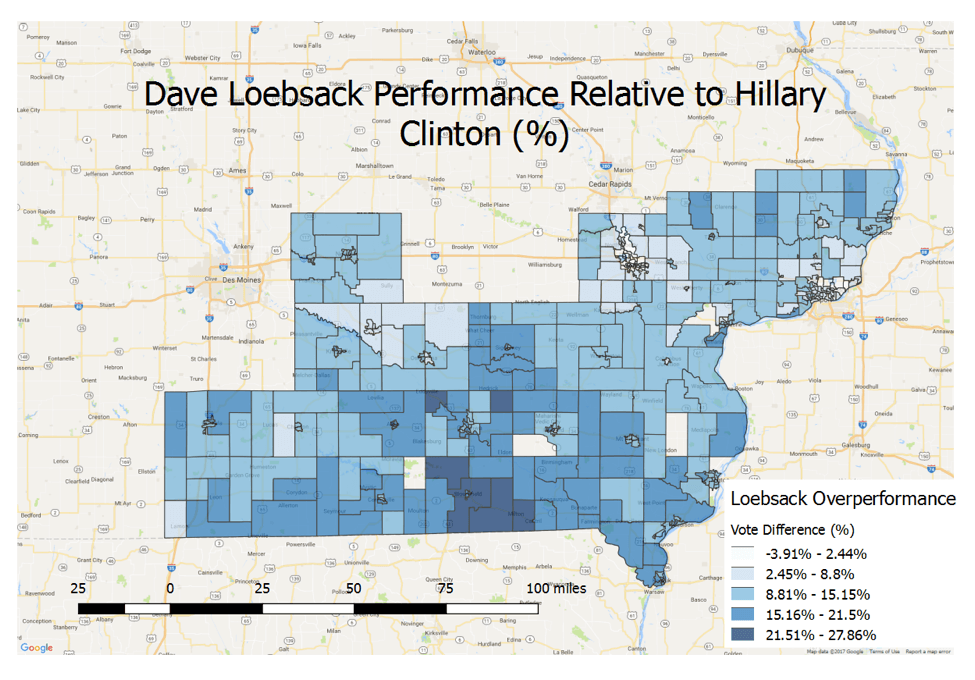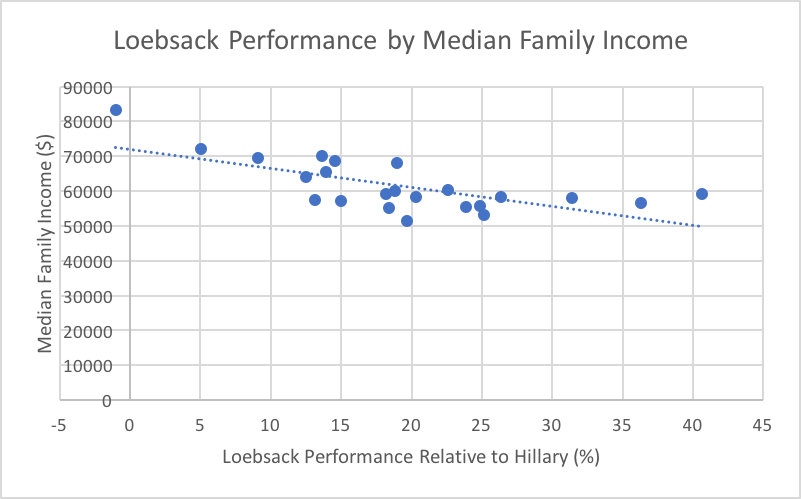
Guest post from Grant Gregory
In the 2016 presidential elections, Iowa shifted away from Democrats more than any other swing state in the country, realizing a total margin shift of 15.2%. This shift yielded large losses for Democrats down the ballot as well – Democrats in Iowa’s 1st District, 3rd District, and state legislative races across the state failed to secure victories. Interestingly, Dave Loebsack of Iowa’s 2nd District managed to defy odds and secure a win despite his district voting for Donald Trump by 4 points, a margin wider than both Iowa’s 1st and 3rd Districts.
Loebsack performed so well, he averaged an 11-point difference in votes than Hillary did, winning his district handily by approximately 7 points. What drove the split-ticket voting that resulted in Dave’s win? According to the data, Dave overperformed in rural, small-town communities. In Davis County, a small county with a population of just under 9,000, Loebsack outperformed Hillary by a staggering 41 points. He saw similar margins over Clinton in Monroe (36%) and Van Buren (31%) Counties as well.

Interestingly, Loebsack performed worse than Hillary did in Johnson County, a liberal stronghold and home to his opponent, Dr. Chris Peters. Loebsack’s underperformance in Johnson County may largely be attributable to the fact that Johnson didn’t experience the same Obama/Trump flip that the rest of the counties experienced. Similarly, Loebsack didn’t perform exceptionally well in Scott county, outperforming Hillary by only 5 points.
Using multiple linear regression, I developed a model to control for variables (specifically, unemployment, age, ethnicity, education, incomes and employment in manufacturing) that would determine who split ticket voted by county. The strongest and only statistically significant variable in my analysis determined that the voters who split their ticket Trump/Loebsack had lower household incomes than those who voted down the line. From my model, counties observed a .93% decreased in Loebsack’s overperformance for every additional $1,000 in median family income.
(You can download the full multiple regression spreadsheet here)

Incumbency may also be a contributing factor as to why we didn’t see this split-ticket phenomenon in rural communities across the state. Iowa’s third district only voted for Donald Trump at a margin of 3.5%, but Dave Young (who the DCCC had sought to oust in 2016) managed to win by 15 points. Dave Young, then, outperformed his party’s respective presidential candidates by a similar margin Dave Loebsack did, at approximately 11 points.
Rod Blum also outperformed relative to Donald in Iowa’s first district, securing his second term in the House. Blum, however, overperformed by much smaller margins than Young and Loebsack, by approximately 4 points.
Ultimately, a combination of incumbency and strength in the rural south handed Loebsack his victory and maintained his position as the only Democrat in Iowa’s congressional delegation. Having a voting record helps, but maintaining a message consistent with the struggles of rural Iowans was a fundamental component in holding on to his seat. Going in to 2018, Democrats would do well to follow Loebsack’s footsteps to make ground in the legislature and congress.
by Grant Gregory
Posted 1/12/17

8 Comments on "How Dave Loebsack Beat The Trump Bump"
Hillary might have taken Iowa for granted. It showed in the county totals. Maybe she thought since she did well in the caucusus she would do well in the general. I personally never thought she was electable. Her message was poor and her opponent had a message that reasonated with rural and city voters. Even though she won the popular vote, she lost the electoral votes.
Problem now is that we will have to live with the results for quite a while if Democrats don’t do a through vetting of their processes and campaigns.
Here is the thing I don’t get though. Hillary got 3rd on caucus night in 08 and barely by the slimmest of slim margins beat Bernie on caucus night for 2016. Given that fact, I don’t get why she didn’t pay attention barely at all to Iowa after the national convention. It is not like Iowa showed her that much of a vote of confidence either caucus, in spite of her extremely slim win in this election’s caucus.
Now this is a joke I have shared privately with people, not a fact but, it illustrates the point…… President Obama was in Iowa so many times during his elections that I wondered if he didn’t have a secret cabin by Ledges or Lake Okoboji. I get that he didn’t actually have one, hence the joke but, it drives the point home that Hillary pretty much ignored Iowa and the midwest in comparison. Heck, even former Gov. and soon to be former Sec of Ag Vilsack slammed Hillary’s strategies or lack there of with rural voters and farmers. The proof is in the numbers.
Unfortunately we do have to live with the results but, it does not mean every fight is lost. If democrats as a whole get our acts together and listen to the voters at large, not just party insiders and staunch democrats, we could make Trump’s and the republican’s lives miserable come 2018. Loebsak, albeit in a congressional race, knew he had to reach out in his entire district. That is why he outdid Hillary’s numbers in his district. A national campaign does not have the same advantages on a county level but, the performance numbers show that maybe paying attention to what is going on when it comes to the county level a bit more may have done some good. Coming up with policies to speak to these voters along with city voters is where it is at. Iowa is not a metropolitan state. To treat it like that is foolish if you want Iowa’s electoral votes.
Loebsack ran well where Democrats have always run well. Whether it’s Davis County or cities like Fort Madison and Clinton, Democrats held Hillary Clinton responsible for what President Obama did to working folks. The Congress wasn’t held responsible because much of the changes were done by The President, without congressional action. But Democrats could benefit by considering Loebsack’s measured approach to rural areas and independent voters. But that might lead to more moderate Democrat positions on issues, a direction not likely to happen. The good news is that the Trump Administration might actually improve the economy in places like southeast Iowa, making it easier for incumbents to win re-election in the future.
There can be no claims to statistical significance unless your data were from a properly drawn sample of a population. The software knows not of where you derive your data and poops out the “significance” estimates nonetheless. You are analyzing the actual results of the district population at the county level, not a sample. Accordingly, you can say which variables seemed to explain more variance or less or the increments to variance explained by the addition of variables, but the use of the phrase “statistical significance” is not warranted.
Thanks for this, Dave. The regression model is flawed (N= 24 with 6 independent variables is hard to run a proper analysis) but it does well to provide a general overview of what determined the split ticket vote. One thing I was concerned about with this model was the relationship education had with incomes, although education had little explanatory power, if I were to run my analysis without income, education would be significant (or whatever term you would prefer to be used in this context) because education and incomes have such a strong correlation. Feel free to respond with the appropriate terminology for the results of the regression model.
In Johnson County there’s a small chunk of the pacifist left who are bitter that, after he beat the only anti-Iraq War Republican, Dave didn’t turn out to be Dennis Kucinich, and they’ve held him to unrealistic expectations ever since. Maybe out of fear of Trump they held their noses for Hillary (a lot probably wrote in Bernie) but these folks likely used libertarian “Republican” Christopher Peters as their middle finger to the Democrats. Since Loebsack was considered “safe” they saw few consequences in using that as their protest vote.
It would also be interesting to see how Congressman Loebsack’s % of win… correlated to local courthouse races. At least here on the western fringe of Congressional District 2, there were lots of courthouse seats that were uncontested and currently held by Republican. That surely must have some relevance to turnout or to straight-ticket voting. Clarke County Democrats won all 3 of their courthouse races and we remain one of the very few counties in the area which has half of our courthouse positions filled by Democrats. The IDP seems to have little interest in even noticing rural counties; either their success or their lack there of.
In July I moved to Coralville from Iowa’s 1st District, so I am not knowledgeable about Loebsack’s small town/rural voter outreach and policies. The pundits are speculating that the Democrats need to give more attention to small town/rural/working class voters. I would like a summary of what Loebsack did through 2015/2016 to talk to these demographics and what policies he has worked on that directly benefit them that they appreciated and voted for. Aren’t you advocating replicating Loebsack’s specific outreach and policies to motivate the voters and garner the votes?